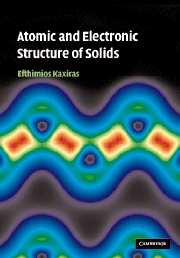Book contents
11 - Defects III: surfaces and interfaces
Published online by Cambridge University Press: 06 July 2010
Summary
Two-dimensional defects in crystals consist of planes of atomic sites where the solid terminates or meets a plane of another crystal. We refer to the first type of defects as surfaces, to the second as interfaces. Interfaces can occur between two entirely different solids or between two grains of the same crystal, in which case they are called grain boundaries.
Surfaces and interfaces of solids are extremely important from a fundamental as well as from a practical point of view. At the fundamental level, surfaces and interfaces are the primary systems where physics in two dimensions can be realized and investigated, opening a different view of the physical world. We have already seen that the confinement of electrons at the interface between a metal and a semiconductor or two semiconductors creates the conditions for the quantum Hall effects (see chapters 7 and 9). There exist several other phenomena particular to 2D: one interesting example is the nature of the melting transition, which in 2D is mediated by the unbinding of defects. Point defects in 2D are the equivalent of dislocations in 3D, and consequently have all the characteristics of dislocations discussed in chapter 10. In particular, dislocations in two dimensions are mobile and have long-range strain fields which lead to their binding in pairs of opposite Burgers vectors. Above a certain temperature (the melting temperature), the entropy term in the free energy wins and it becomes favorable to generate isolated dislocations; this produces enough disorder to cause melting of the 2D crystal. At a more practical level, there are several aspects of surfaces and interfaces that are extremely important for applications.
- Type
- Chapter
- Information
- Atomic and Electronic Structure of Solids , pp. 385 - 429Publisher: Cambridge University PressPrint publication year: 2003



